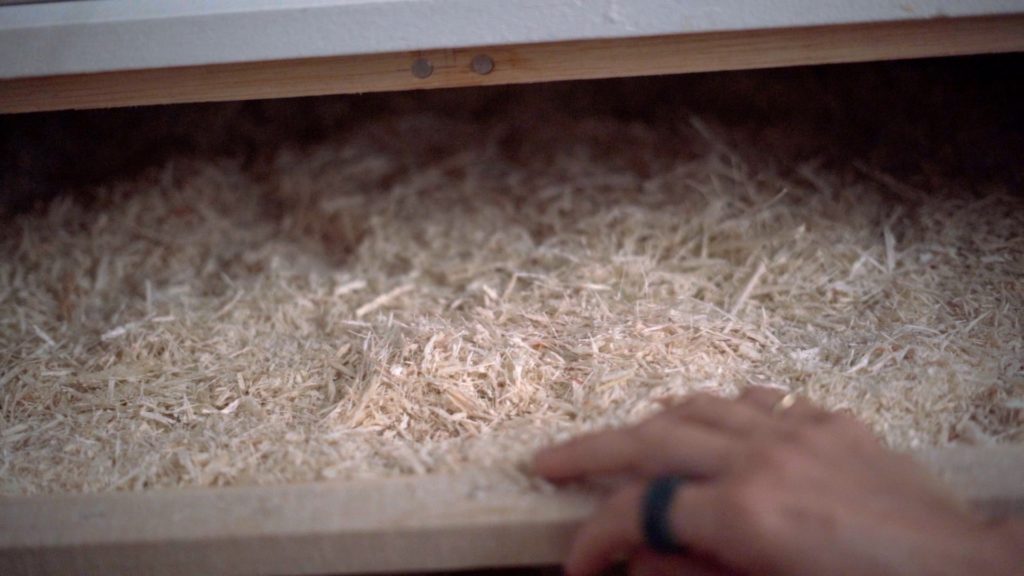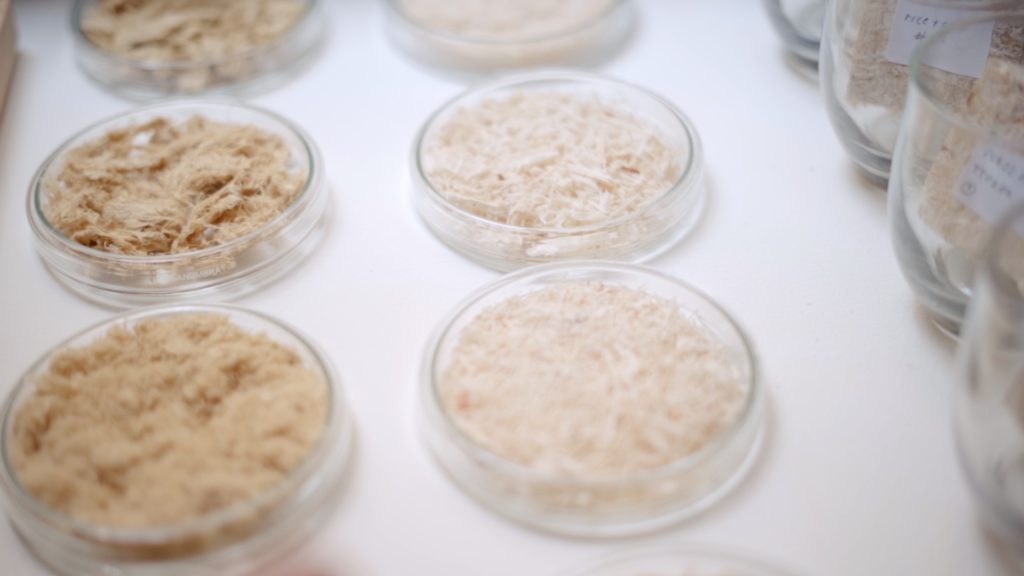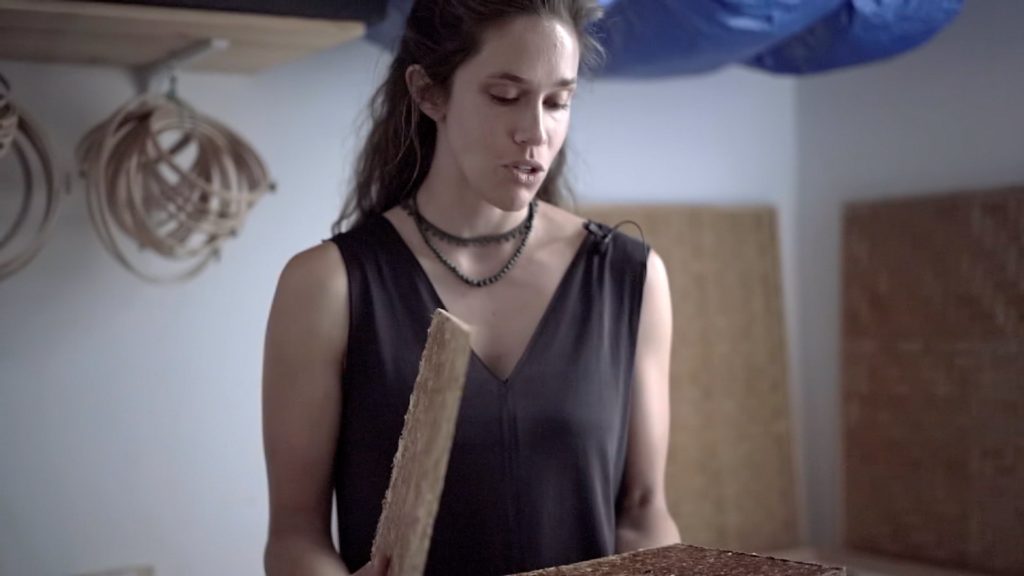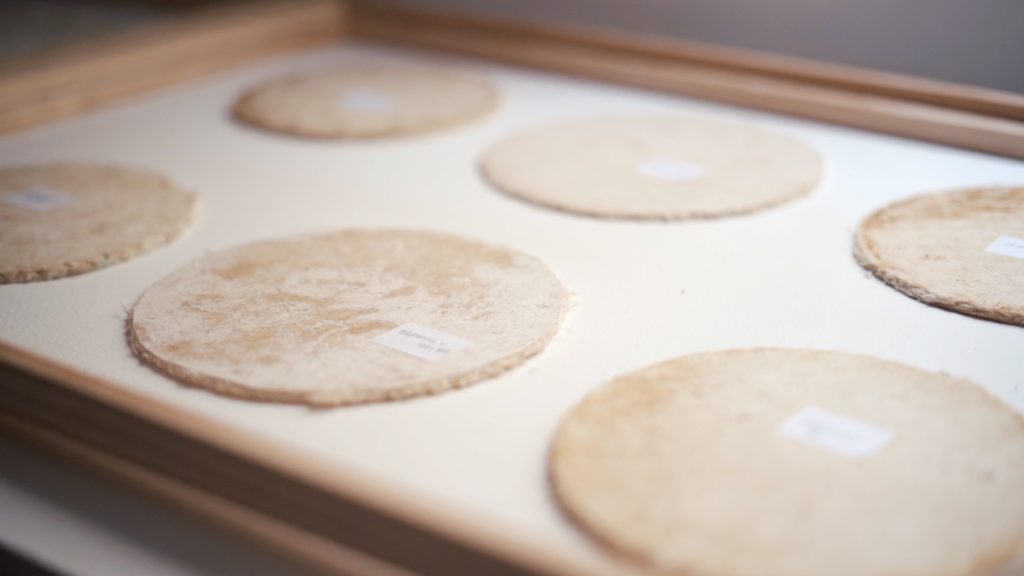
Transforming sugarcane waste into objects that last
From MDEF student to Fab Lab resident: Follow Julia’s explorative journey into waste-based materials
Meet Barcelona-based designer, maker and artist of craft Julia Steketee. With an educational and professional background in furniture design, she enrolled in the Master of Design for Emergent Futures (MDEF) experienced in working with a variety of materials. During MDEF and after graduating in 2022, Julia has been incorporating regenerative practices, natural building techniques, and the principles of the circular economy into her design practice.
In the following interview, she opened the doors to her studio to share her experience as an MDEF student and a Fab Lab Barcelona staff member, while allowing us to take a peek into her design practice focused on local, waste-based material exploration and research.
1. Can you introduce yourself and tell us about your background?
My background is in craft and fabrication. I have a lot of experience with metalworking, woodworking, ceramics, and also textiles. I studied furniture design for my undergraduate degree and afterwards, I worked for two different furniture designers. I also worked for a sculpture artist helping to produce ceramic, metal and wooden sculptures. I love making things, spending time in the studio, and experimenting with new materials. I also keep up my own artistic and textile practice in my free time.
2. How did you decide to apply to MDEF?
With the constant news of doom and gloom, I began reflecting more seriously on my impact on the planet. I recognized that with my making processes and my career path, I wasn’t making a positive impact on the climate. Sometimes it can feel kind of egotistical to be an artist or a designer when there are so many pressing problems, injustices across the world, and an ongoing environmental emergency. I feel that climate change has become the problem of our time.
I wanted to explore different creative avenues and consider how I could have a positive impact rather than a negative one. From my experience producing objects, be it furniture or sculptures, there is often a lot of waste in the making process. Also, fields like furniture design and fine art often involve making beautiful things for rich people with very elegant homes. I decided to join MDEF, to explore other options for what my career in design could be.
3. What would you recommend to your past self about coursing MDEF?
I would recommend my past self during MDEF to stay focused because the program is extremely exploratory. I already have a very exploratory personality. I love to try new things and I can easily get distracted with new projects and ideas. I think that it’s quite easy to have a great idea, but it’s challenging to take the idea and turn it into something that people can understand, interact with, or experience. With more focus, I think I would have felt more satisfied with my work during that year. I tried out lots of things like coding, grasshopper, 3D printing with food waste, and hosting workshops but in the end, I felt I needed more time to sit down, reflect, and figure out what my goal was.
4. Are you working on a particular project that was born during the master?
I’ve always been drawn to working with my hands and experimenting with different materials but before MDEF I had never worked with waste materials and the idea of creating materials from scratch was completely new to me. I started experimenting with mycelium to develop materials for fabrication during the first trimester of MDEF. I collaborated with Roberto Broce to teach a series of workshops about how to grow mycelium for bioremediation and as a fabrication material. Some types of mycelium can digest certain types of plastics and you can also grow it on agricultural waste and mold it into forms to create bricks, insulation panels, or packaging. After the workshops, I continued to do more experiments with mycelium, growing and molding it at home and at IAAC.
During MDEF, we took a course called Remixing Materials, which was my favorite by far. I connected a lot with the concept of turning waste into something valuable. We were encouraged to work with restaurants or nearby industries to collect specific types of waste and try out material recipes using that waste. I liked how we got to put the idea of the circular economy into action at a very small, grassroots scale. I really enjoyed the process of mixing and experimenting without knowing exactly what the final result would be. The processes evolve all the time. They involve a lot of trying, failing, trying again, and learning from the mistakes made. A lot of patience is required but I find the process to be a lot of fun.
Leading the mycelium workshops and taking part in the Remixing Materials class got me thinking about how I could become a material designer and develop materials that have a positive environmental impact as opposed to petroleum plastics and carbon-intensive materials like concrete. So, in a way, my ongoing project to become a bio-based material designer started during MDEF. The program allowed me to experiment with loads of different restaurant and industry waste streams including sugarcane waste – which sparked the idea for the project I am currently working on.
‘One thing that I learned in MDEF was to try to put myself out there even when I didn’t yet have much of a community, credibility or support.’
5. What was the final project that you worked on during MDEF?
My final MDEF project was called ‘REsource’. My idea was to create a meeting place for people to publish and share toolkits, knowledge, and events related to biomaterial design, the circular economy, and sustainable material alternatives. This online platform prototype went hand in hand with a workshop and exhibition that I organized in collaboration with fellow MDEF students. During the workshop, Marina Lermant and I demonstrated how to make bioplastics from algae and biocomposites from eggshells. We took a lot of inspiration from Fab Lab’s ‘Remix el Barrio’ project. Following the same methodology, we collected food waste from local restaurants in Poblenou and transformed the waste into natural dyes and new materials.
‘REsource’ was a concept and I decided not to develop it further after finishing MDEF. I felt that it was a big leap for me to try and create an online platform and convince people to use it. Instead, I pivoted and decided to dedicate more time and energy to learning about waste-based material development. I took a lot of the learnings from the ‘REsource’ project, workshops, and exhibition and I’ve incorporated these ideas into the project that I am working on now. Using wasted resources and following the principles of the circular economy are core to this new project.
6. What is the current project you are working on?
It’s called ‘Bagaceira Project’. I’m developing materials from the bagasse which is the main byproduct of the sugarcane industry. I felt I needed to hone in on one material and get to know its composition, properties and behavior better. This material is guiding me as I learn what it takes to develop new material formulas and scale them up for application in artistic, furniture, interior design, and architectural projects. I was interested in sugarcane bagasse because it’s a material that’s found in mass in many regions across the globe. Sugarcane is the world’s largest crop so that makes bagasse one of the world’s most abundant agrowastes. But I also needed to choose a material that I could access at a smaller scale, locally, in order to start prototyping.
7. Where do you find the sugar cane you are using for your material exploration?
I’m working with a Brazilian restaurant, Infusion Food, just a five minute bike ride from my apartment and studio space and I pick up the sugarcane waste after they press it for juice. They have a machine where you feed the sugarcane through a press and the juice comes out the other side. They throw away the remaining fibrous pulp which is called bagasse. I usually swing by at the end of the day on the weekends because they have more customers and therefore more people order sugarcane juice. I come with a big bag, they fill it with the pulp and then I take it home on my bike.
From there, I dry it, blend it or boil it to modify the fibers. I have been trying out different treatment and fabrication methods. Some of the materials recipes require binders to stick the fibers together. I use natural binders and additives, like algae, mycelium and plant starches to explore the plethora of material possibilities that can come from bagasse and now I have a library of different bagasse-based material samples.
8. What are you planning to do with the different samples?
There’s a lot of options. I’ve started by making prototypes for lamp shades and I’ve also created some woven panels that could be used for cabinet or closet doors, room dividers or decorative panels. Those are sort of easy applications in the sense that they don’t need to be structural. No one is going to sit on them. However some of my materials samples, such as the fiberboard and particleboard samples, could potentially work for tables, chairs and shelving. But I’ll need to develop these materials further, make sure they meet the performance standards and produce them in larger quantities. I’ve done a bunch of material tests to understand how my samples compare to others on the market and that’s been helpful in understanding which materials are worth pursuing further and for which product applications. Also, I’m hoping to find collaborators to help me produce the materials at scale and do more rigorous material testing.
9. Another part of your practice is your time spent working for Fab Lab Barcelona after you graduated MDEF. Can you tell us a bit more about that transition from student to a staff member and what it is to be on the other side?
After MDEF, I started working with the Fab Lab and the EU CENTRINNO project through the Research Residency Program and continued working with the team to help organize and design the exhibition, POBLENOU FABRICA. My role also focused on bringing local craftspeople to the Make Works Catalonia platform, which aims to promote local production by connecting designers, artisans, manufacturers and material suppliers.
I really enjoyed being part of a more established community in Barcelona. During the MDEF course, our tutors and teachers encouraged us to collaborate with other creatives or community organizations in the city. I was able to do a bit of this during the course but once I joined the Fab Lab Team, I felt it gave me a lens into lots of community projects that were going on in the city and I got to connect with many of the people behind them. Working on the CENTRINNO project and the exhibition, allowed me to recognize the importance and impact that developing partnerships with organizations and individuals across the city can have. For example, the POBLENOU FABRICA exhibition and event series could not have happened without the collaboration of the countless organizations and individuals involved. I now feel much more integrated in the neighborhood network, which is amazing!
10. As a staff member, you have worked on projects related to MDEF. Can you tell us in which ways?
As part of CENTRINNO, I worked on mapping out different makers and organizations to understand the circular opportunities within the neighborhood of Poblenou. We used a platform called Kumu to plot out the relationships between different local actors and waste streams.
This project felt very related to some of my research from MDEF because during the course I identified and reached out to different restaurants that produced different types of organic waste in Poblenou. With CENTRINNO, we focused on wood waste instead of food waste. We mapped wood workers, wood suppliers, demolition sites, and possible uses for the sawdust or woodchips. A lot of the connections that we mapped out are hypothetical, but some of them do already exist.
Also, I got the chance to teach an MDEF class with Audrey Belliot, a fellow MDEF alumni. We worked with the students to help them plan their collaborative events that formed part of the MDEFest. Audrey and I really enjoyed putting together workshops, events and exhibitions as part of our end-of-year festival. It was great to be able to re-live that process but from a different perspective. We helped to guide the students to find a theme and name for the festival and choose locations to host their events. We took a lot of inspiration from our planning process from the previous year, but we also did change our approach quite a bit. I think with every year, adjustments will be made depending on the students and on how the MDEFest evolves over time.
11. What would you have liked to know as a student that you know now as staff?
When you come to a new city, contacting people can feel very nerve wracking. There’s often an element of apprehension or timidness. One thing that I learned in MDEF was to try to put myself out there even when I didn’t yet have much of a community, credibility or support.
It’s also a lesson for life. You’re not always gonna have the support you need. But if you identify what you are lacking, be it technical knowledge, an audience, networks, or facilities, you can always reach out to strangers, ask around and see how you can find the missing link in the equation. Finding ways to return the favor or give back in some way is key in making these types of partnerships work.
12. Any highlights you would like to mention from working in Fab Lab Barcelona?
I really enjoyed the camaraderie of the Fab Lab team. Everyone is really hard working and puts a lot of soul and energy into the projects. It was exciting to see how much we could get done in a short time, with a small team, and a strong collaborative spirit. I really enjoyed helping to organize and curate the POBLENOU FABRICA Exhibition and planning and participating in the workshop series taught by local craftspeople. I also had a lot of fun building the display structures for the exhibition with others from the team. We managed to construct everything using salvaged wood.
13. Finally, what are your thoughts about the future?
In general, I’m a very positive person but I don’t have a super positive outlook for the future. So much needs to change to mitigate the effects of climate change and prevent the collapse of biodiversity. We need to redesign just about every industry. It’s honestly so daunting.
Something that gives me peace is that in the end, we’re animals and we’re part of a much larger global cycle, an evolution of living beings on the planet. This is not to say that we lack agency or control over what lies ahead. Even if our impact seems so small in the scheme of things, I still believe it’s important to feel that we are participating and contributing to a shift towards a future that we want to live in.
My outlook on the future changes day to day. It’s become more positive now that I have become more involved and more aware of a lot of projects that are combating climate change and promoting more sustainable living practices. There are honestly so many diverse solutions but it’s going to take a lot of dedication and collective effort to put them into place at scale.
Feel inspired?
Discover MDEF and follow Julia in challenging the way things work today by designing for the future!



